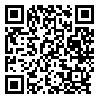شمارۀ جدید فصلنامه (پاییز1404) منتشر شد
دوره 13، شماره 2 - ( 12-1401 )
جلد 13 شماره 2 صفحات 172-149 |
برگشت به فهرست نسخه ها
Download citation:
BibTeX | RIS | EndNote | Medlars | ProCite | Reference Manager | RefWorks
Send citation to:



BibTeX | RIS | EndNote | Medlars | ProCite | Reference Manager | RefWorks
Send citation to:
Shadmanfaat S M, Rahmati M M. (2023). Sociological explanation of cyberbullying among Gilan University students with emphasis on situated action theory. Social Problems of Iran. 13(2), 149-172.
URL: http://jspi.khu.ac.ir/article-1-3492-fa.html
URL: http://jspi.khu.ac.ir/article-1-3492-fa.html
شاد منفعت سیده معصومه، رحمتی مهدی.(1401). تبیین جامعهشناختی قلدری سایبری در بین دانشجویان دانشگاه گیلان با تأکید بر تئوری کنش موقعیتمند مسائل اجتماعی ایران 13 (2) :172-149
1- دانشجوی دکتری جامعهشناسی فرهنگی دانشگاه گیلان، ایران ، shamila.shadmanfaat@gmail.com
2- دانشیار، عضو هیئتعلمی گروه علوم اجتماعی دانشگاه گیلان. ایران
2- دانشیار، عضو هیئتعلمی گروه علوم اجتماعی دانشگاه گیلان. ایران
چکیده: (2833 مشاهده)
هدف اصلی این مقاله، بررسی چرایی درگیری کاربران شبکههای اجتماعی در قلدری سایبری با استفاده از تئوری کنش موقعیتمند است. بدینمنظور با استفاده از نمونۀ 380 نفری از دانشجویان دختر و پسر دانشگاه گیلان که به روش نمونهگیریِ در دسترس انتخاب شدند، مفروضههای تئوری کنش موقعیتمند مورد بررسی قرار گرفت. نتایج حاکی از آن است که خودکنترلی پایین (ضریب بتا: 180/0)، اخلاقیات پایین (ضریب بتا: 130/0)، بازدارندگی ادراکشده پایین (ضریب بتا: 090/0) و بستر اخلاقی انحرافی (ضریب بتا: 337/0) تأثیر معناداری بر مشارکت دانشجویان در قلدری سایبری دارند. همچنین، سطح تحصیلات (ضریب بتا: 097/0-)، سن (ضریب بتا: 116/0-)، وضعیت تأهل (ضریب بتا: 090/0-) و جنسیت (ضریب بتا: 124/0)، احتمال افزایش قلدری سایبری را ارتقا میبخشد. افزون بر آن، تمایلات کجروانه رابطۀ بستر مجرمانه و قلدری سایبری را تعدیل میکند.
نوع مقاله: پژوهشی اصیل |
موضوع مقاله:
جرم و انحرافات
دریافت: 1401/3/10 | پذیرش: 1401/6/22 | انتشار: 1401/12/22
دریافت: 1401/3/10 | پذیرش: 1401/6/22 | انتشار: 1401/12/22
فهرست منابع
1. علیوردینیا، اکبر؛ ملکدار، اعظم و حسنی، محمدرضا (1392). تخلفات رایانهای در میان دانشجویان دانشگاه مازندران: آزمون تجربی نظریۀ یادگیری اجتماعی ایکرز. مجله جامعهشناسی ایران، 15(2): 24-56.
2. علیوردینیا، اکبر و ریسمانچی، ناهید (1398). تأثیر بزهدیدگی سایبری و سنتی بر رفتارهای انحرافی دانشجویان. فصلنامه علمی پژوهشی راهبرد فرهنگ، 12(45): 97-130.
3. علیوردینیا، اکبر و قربانزادهسیاهکلرودی، فائزه (۱۳۹۹). بررسی جامعهشناختی بزهدیدگی ناشی از آزاررسانی سایبری در میان دانشجویان دانشگاه مازندران. مسائل اجتماعی ایران (دانشگاه خوارزمی)، ۱۰ (۱): ۱۴۵-۱۶۹.
4. صدیقیانبیدگلی، آمنه (1400). وضعیت انحرافات سایبری در میان دانشجویان دانشگاههای تهران. فصلنامه مطالعات فرهنگ و ارتباطات، 1(1): 1-21.
5. آهنگرقربانی، زهره؛ عطادخت، اکبر؛ معزز، رقیه و سپهرینسب، زهرا (1398). نقش میانجی تکانشگری در رابطۀ صفات سهگانه تاریک شخصیت با آزارگری سایبری: مطالعهای میان دانشجویان. فصلنامه پژوهشهای نوین روانشناختی، 14(54): 1-21.
6. ترکاشوند، معصومه و کرامتی، هادی (1400). پیشبینی انواع قلدری بر اساس زیرمقیاسهای گسست اخلاقی و هویت اخلاقی در دانشآموزان مقطع ابتدایی شهر تهران. تفکر و کودک، 12(2): 93-110.
7. حبیبیکلیبر، رامین و صیادی، صادق (1400). تأثیر انسجام خانوادگی و گروه همسالان با رفتارهای قلدرانه دانشآموزان. مطالعات جنسیت و خانواده، 9(1): 93-113.
8. علیوردینیا، اکبر و سهرابی، مریم (1394). تحلیل اجتماعی قلدری در میان دانش آموزان (مطالعه موردی دوره متوسطه شهر ساری). مطالعات توسعه اجتماعی -فرهنگی، ۴ (۱): ۳۹-۹.
9. رسولی، الهام؛ عباسی، رسول و معینی، حسین (1397). بررسی تأثیر کیفیت خدمات الکترونیکی بر قصد خرید اینترنتی کتاب با نقش میانجی اعتماد و تصویر شرکت. کتابداری و اطلاعرسانی، 21(1): 153-179.
10. عطادخت، اکبر؛ احمدی، شیرین و فلاحی، وحید (1399). بررسی الگوی روابط ساختاری پرخاشگری سایبری بر اساس استرس ادراکشده با نقش میانجی وابستگی به شبکههای مجازی در دانشجویان دانشگاه محقق اردبیلی در سال ۱۳۹۸: یک مطالعه توصیفی. مجله دانشگاه علوم پزشکی رفسنجان، ۱۹ (۳): ۲۶۴-۲۵۱.
11. Abaido, G. M. (2020). Cyberbullying on social media platforms among university students in the United Arab Emirates. International Journal of Adolescence and Youth, 25(1), 407-420. [DOI:10.1080/02673843.2019.1669059]
12. Akarsu, Ö., Budak, M. İ., & Okanlı, A. (2022). The relationship of childhood trauma with cyberbullying and cyber victimization among university students. Archives of Psychiatric Nursing, 41, 181-187. [DOI:10.1016/j.apnu.2022.06.004]
13. Baier, D., Hong, J. S., Kliem, S., & Bergmann, M. C. (2019). Consequences of bullying on adolescents' mental health in Germany: Comparing face-to-face bullying and cyberbullying. Journal of Child and Family Studies, 28(9), 2347-2357. [DOI:10.1007/s10826-018-1181-6]
14. Barton-Crosby, J., & Hirtenlehner, H. (2021). The role of morality and self-control in conditioning the criminogenic effect of provocation. A partial test of situational action theory. Deviant Behavior, 42(10), 1273-1294. [DOI:10.1080/01639625.2020.1738645]
15. Bernardo, A. B., Galve-González, C., Cervero, A., & Tuero, E. (2022). Cyberbullying in first-year university students and its influence on their intentions to drop out. Higher Education Research & Development, 1-15. [DOI:10.1080/07294360.2022.2057447]
16. Camacho, S., Hassanein, K., & Head, M. (2014). Understanding the factors that influence the perceived severity of cyber-bullying. Paper presented at the International Conference on HCI in Business. [DOI:10.1007/978-3-319-07293-7_13]
17. Cao, X., Khan, A. N., Ali, A., & Khan, N. A. (2019). Consequences of cyberbullying and social overload while using SNSs: A study of users' discontinuous usage behavior in SNSs. Information Systems Frontiers, 1(1), 1-14.
18. Craig, J. M. (2019). Extending situational action theory to white-collar crime. Deviant Behavior, 40(2), 171-186. [DOI:10.1080/01639625.2017.1420444]
19. Donat, M., Willisch, A., & Wolgast, A. (2022). Cyber-bullying among university students: Concurrent relations to belief in a just world and to empathy. Current Psychology, 1-14. [DOI:10.1007/s12144-022-03239-z]
20. Foody, M., Samara, M., & Carlbring, P. (2015). A review of cyberbullying and suggestions for online psychological therapy. Internet Interventions, 2(3), 235-242. [DOI:10.1016/j.invent.2015.05.002]
21. Hinduja, S., & Patchin, J. W. (2010). Bullying, cyberbullying, and suicide. Archives of suicide research, 14(3), 206-221. [DOI:10.1080/13811118.2010.494133]
22. Hirtenlehner, H., & Hardie, B. (2016). On the conditional relevance of controls: An application of Situational Action Theory to shoplifting. Deviant Behavior, 37(3), 315-331. [DOI:10.1080/01639625.2015.1026764]
23. Hirtenlehner, H., & Treiber, K. (2017). Can situational action theory explain the gender gap in adolescent shoplifting? Results from Austria. International Criminal Justice Review, 27(3), 165-187. [DOI:10.1177/1057567717690199]
24. Kabiri, S., Shadmanfaat, S. M., Samuels-Wortley, K., & Gallupe, O. (2020). Does Moral Identity Matter in Situational Action Theory? Some Evidence of Iranian Fans' Cyberbullying Perpetration. International Criminal Justice Review, 30(4), 406-420. [DOI:10.1177/1057567720941584]
25. Kabiri, S., Shadmanfaat, S. M. S., Choi, J., & Yun, I. (2020). The impact of life domains on cyberbullying perpetration in Iran: A partial test of Agnew's general theory of crime. Journal of Criminal Justice, 66, 1-30. doi: [DOI:10.1016/j.jcrimjus.2019.101633]
26. Lee, S.-S., Song, H., & Park, J. H. (2021). Exploring risk and protective factors for cyberbullying and their interplay: evidence from a sample of South Korean college students. International journal of environmental research and public health, 18(24), 13415. [DOI:10.3390/ijerph182413415]
27. Li, C. K., Holt, T. J., Bossler, A. M., & May, D. C. (2016). Examining the mediating effects of social learning on the low self-control-Cyberbullying relationship in a youth sample. Deviant Behavior, 37(2), 126-138. [DOI:10.1080/01639625.2014.1004023]
28. Liu, W., Qiu, G., & Zhang, S. (2022). Situational action theory and school bullying: Rethinking the moral filter. Crime & Delinquency, 68(4), 572-593. [DOI:10.1177/0011128720974318]
29. Menesini, E., Nocentini, A., & Camodeca, M. (2013). Morality, values, traditional bullying, and cyberbullying in adolescence. British Journal of Developmental Psychology, 31(1), 1-14. [DOI:10.1111/j.2044-835X.2011.02066.x]
30. Patchin, J. W., & Hinduja, S. (2011). Traditional and nontraditional bullying among youth: A test of general strain theory. Youth and Society, 43(2), 727-751. [DOI:10.1177/0044118X10366951]
31. Patchin, J. W., & Hinduja, S. (2013). Cyberbullying among adolescents: Implications for empirical research. Journal of Adolescent Health, 53(4), 431-432. [DOI:10.1016/j.jadohealth.2013.07.030]
32. Piquero, A. R., Bouffard, J. A., Piquero, N. L., & Craig, J. M. (2016). Does Morality Condition the Deterrent Effect of Perceived Certainty Among Incarcerated Felons? Crime & Delinquency, 62(1), 3-25. [DOI:10.1177/0011128713505484]
33. Schoepfer, A., & Piquero, A. R. (2006). Self-control, moral beliefs, and criminal activity. Deviant Behavior, 27(1), 51-71. [DOI:10.1080/016396290968326]
34. Masoomeh (Shamila) Shadmanfaat, S., Kabiri, S., Smith, H., & Cochran, J. K. (2020). A longitudinal study of Iranian fans' cyberbullying: The utility of social learning theory. Deviant Behavior, 41(12), 1616-1635. [DOI:10.1080/01639625.2019.1637996]
35. Shadmanfaat, S., Kabiri, S., Miley, L. N., Howell, C. J., Muniz, C. N., & Cochran, J. K. (2020). Performance Enhancing Drug Use Among Professional Athletes: Testing the Applicability of Key Theoretical Concepts Derived From Situational Action Theory. Journal of Sport and Social Issues, 44(4), 336-355. [DOI:10.1177/0193723520919812]
36. Shadmanfaat, S., Kabiri, S., Miley, L. N., Howell, C. J., Muniz, C. N., & Cochran, J. K. (2020). Performance enhancing drug use among professional athletes: Testing the applicability of key theoretical concepts derived from situational action theory. Journal of Sport and Social Issues, 44(4), 336-355. [DOI:10.1177/0193723520919812]
37. Shadmanfaat, S., Richardson, D. A., Muniz, C. N., Cochran, J. K., Kabiri, S., & Howell, C. J. (2021). Cyberbullying against rivals: Application of key theoretical concepts derived from situational action theory. Deviant Behavior, 42(12), 1549-1564. [DOI:10.1080/01639625.2020.1762452]
38. Shadmanfaat, S. M., Choi, J., Kabiri, S., & Lee, J. (2021). Impact of social concern on cyberbullying perpetration in Iran: Direct, indirect, mediating, and conditioning effects in Agnew's social concern theory. Deviant Behavior, 42(11), 1436-1457. [DOI:10.1080/01639625.2020.1753152]
39. Shadmanfaat, S. M., Choi, J., Kabiri, S., & Yun, I. (2020). Assessing the links between parenting practices, moral emotions, and cyberbullying perpetrations among a sample of Iranian sports fans. International journal of offender therapy and comparative criminology, 64(16), 1674-1695. [DOI:10.1177/0306624X20923252]
40. Shadmanfaat, S. M. S., Howell, C. J. M., Muniz, C. N., Cochran, J. K., Kabiri, S., & Richardson, D. A. (2018). The predictive ability of self-control and differential association on sports fans' decision to engage in cyber bullying perpetration against rivals. International Journal of Cyber Criminology, 12(2), 362-379.
41. Shadmanfaat, S. M., Howell, C. J., Muniz, C. N., Cochran, J. K., Kabiri, S., & Fontaine, E. M. (2020). Cyberbullying perpetration: An empirical test of social learning theory in Iran. Deviant Behavior, 41(3), 278-293. [DOI:10.1080/01639625.2019.1565513]
42. Song, H., & Lee, S.-S. (2021). Motivations, propensities, and their interplays on online bullying perpetration: A partial test of situational action theory. Crime & Delinquency, 66(12), 1787-1808. [DOI:10.1177/0011128719850500]
43. Vazsonyi, A. T., Machackova, H., Sevcikova, A., Smahel, D., & Cerna, A. (2012). Cyberbullying in context: Direct and indirect effects by low self-control across 25 European countries. European Journal of Developmental Psychology, 9(2), 210-227. [DOI:10.1080/17405629.2011.644919]
44. Wang, L., & Ngai, S. S.-y. (2020). The effects of anonymity, invisibility, asynchrony, and moral disengagement on cyberbullying perpetration among school-aged children in China. Children and Youth Services Review, 119, 105613. [DOI:10.1016/j.childyouth.2020.105613]
45. Wang, X., Yang, L., Yang, J., Wang, P., & Lei, L. (2017). Trait anger and cyberbullying among young adults: A moderated mediation model of moral disengagement and moral identity. Computers in Human Behavior, 73, 519-526. [DOI:10.1016/j.chb.2017.03.073]
46. Wei, H., Ding, H., Liu, M., & He, A. (2022). The relationship between filial piety belief and cyberbullying perpetration among Chinese university students: A conditional process analysis. Current Psychology, 1-10. [DOI:10.1007/s12144-022-03518-9]
47. Wikström, P. O. H. (2019). Explaining crime and criminal careers: The DEA model of situational action theory. Journal of Developmental and Life-Course Criminology, 6, 188-203. [DOI:10.1007/s40865-019-00116-5]
48. Wikström, P.-O. H., Oberwittler, D., Treiber, K., & Hardie, B. (2012). Breaking rules: The social and situational dynamics of young people's urban crime. Oxford: Oxford University Press.
49. Wikström, P.-O. H., & Svensson, R. (2010). When does self-control matter? The interaction between morality and self-control in crime causation. European Journal of Criminology, 7(5), 395-410. [DOI:10.1177/1477370810372132]
50. Wikström, P.-O. H., & Treiber, K. H. (2009). Violence as situational action. International Journal of Conflict and Violence (IJCV), 3(1), 75-96.
51. Wikström, P. O. H. (2014). Why crime happens: A situational action theory. In G. Manzo (Ed.), Analytical Sociology: Actions and Networks (First Edition ed., pp. 71-94): John Wiley & Sons, Ltd. [DOI:10.1002/9781118762707.ch03]
52. Wikström, P. O. H., & Bouhana, N. (2017). Analyzing radicalization and terrorism: A situational action theory. The handbook of the criminology of terrorism, 25(2), 175-186. [DOI:10.1002/9781118923986.ch11]
53. Wikström, P. O. H., & Treiber, K. (2015). Situational Theory: The Importance of Interactions and Action Mechanisms in the Explanation of Crime. In A. R. Piquero (Ed.), The Handbook of Criminological Theory (Vol. 4, pp. 4415-4444). John Wiley & Sons, Inc. [DOI:10.1002/9781118512449.ch22]
ارسال پیام به نویسنده مسئول
| بازنشر اطلاعات | |
 |
این مقاله تحت شرایط Creative Commons Attribution-NonCommercial 4.0 International License قابل بازنشر است. |







